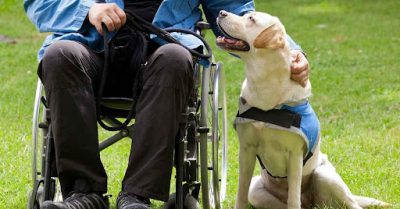Service dogs have become a huge part of many people’s lives, and for good reason! These furry friends provide support, companionship, and a much-needed assistance to their disabled humans. But even if you’re familiar with service dogs, there are likely some things you don’t know about them. In this post, we’ll take a look at 9 surprising facts about service dogs. Whether you’re considering getting a service dog or are just curious about these amazing animals, read on for interesting information!
Table of Contents
1. Service dogs aren’t just for the visually impaired:
While service dogs are most commonly associated with assisting the blind or visually impaired, they can actually be trained to help people with a variety of disabilities. Commonly-seen service dog tasks include retrieving dropped items, opening doors, providing balance assistance, and acting as a calming presence during anxiety attacks or flashbacks. Service dogs can be trained to help those who are deaf or hard of hearing, have seizures, suffer from anxiety or depression, live with autism, and much more. These include hearing impairments, mobility impairments, seizures, diabetes, and more.
2. Service dogs aren’t just for adults:
Service dogs can be of tremendous assistance to children living with disabilities as well. In addition to the common tasks listed above, service dogs for kids can also be trained to help with things like keeping track of a child’s whereabouts, providing reminders to take medication, and intervening if a child is engaging in self-harming behaviors. While the majority of service dog recipients are adults, an increasing number of children with disabilities are also benefiting from these furry helpers. Service dogs can provide much-needed assistance and companionship to kids with a variety of conditions, including autism, ADHD, anxiety disorders, and more.
3. Service dogs aren’t just for people with physical disabilities:
 ;
;
While many people think of service dogs as assistance animals for people with physical disabilities, these furry friends can also be of great help to those with mental health conditions. Service dogs can be trained to perform a variety of tasks that help their humans manage their symptoms and live more independently. For example, a service dog for someone with anxiety might be trained to provide deep pressure therapy or to help with panic attacks.
4. They are allowed to go everywhere:
One of the great things about service dogs is that they are allowed to go just about everywhere with their humans. This includes places like grocery stores, restaurants, hospitals, and even airplanes! In the United States, the Americans with Disabilities Act (ADA) protects the rights of people with disabilities to be accompanied by their service animals in all public places. In most cases, service dogs are not required to have special identification or wear a vest, but their handlers may be asked to provide proof that the animal is a trained service dog.
5. They are highly trained:
Contrary to popular belief, service dogs are not simply pets that have been taught a few tricks. Service dogs undergo extensive training before they are matched with their human partners. Organizations training a service dog can take up to two years and includes socialization, obedience, and task-specific training. Service dog organizations often use positive reinforcement methods to train their dogs, which means the animals are motivated by rewards like treats or praise rather than by punishment. In most cases, service dogs are trained for a specific individual, meaning that they learn the particular tasks that that person needs help with. For example, a service dog for someone with diabetes may be trained to alert their human when their blood sugar is getting low, while a service dog for someone with PTSD may be trained to help them through anxiety attacks.
6. They are not pets:

Although service dogs are often affectionate and loving, they are not considered to be pets, but rather working animals. This means that they are not subject to the same rules and regulations as pet dogs. This is because they perform specific tasks or duties that assist their disabled handlers. For example, service dogs are allowed in public places that do not allow pets, such as restaurants, stores, and airplanes. As working animals, service dogs are protected under the Americans with Disabilities Act (ADA), which gives them access to public places that other animals are not allowed in.
7. Service dogs are different than therapy dogs:
Service dogs are individually trained to perform specific tasks for their handlers, such as retrieving items, opening doors, or providing balance support. Therapy dogs provide emotional support and comfort to people in hospitals, nursing homes, or other settings. They are not individually trained to perform specific tasks like service dogs are. They are not specifically trained to perform certain tasks and are not covered under the ADA.
8. There are different types of service dogs:
Depending on their training, there are three main types of service dogs: guide dogs, hearing dogs, and mobility assistance dogs. While most people think of guide dogs when they think of service dogs, there are actually several different types of service dogs. Guide dogs help people who are blind or have low vision. Hearing dogs assists people who are deaf or hard of hearing. Seizure response dogs alert and provide assistance to people with epilepsy. Psychiatric service dogs help people with mental illnesses such as PTSD, anxiety, and depression. And finally, mobility assistance dogs help people who have difficulty walking or standing. Guide dogs help people who are blind or have low vision, while hearing dogs assist those who are deaf or hard of hearing. Mobility assistance dogs lend a helping paw to people with physical disabilities, such as cerebral palsy or muscular dystrophy.
9. Service dogs come in all shapes and sizes:

Service dogs come in all shapes and sizes, from tiny Chihuahuas to giant Great Danes! While most people envision a Labrador retriever when they think of a service dog, the truth is that there are many different breeds that can be trained to perform various tasks. Labs are certainly one of the most popular breeds, but golden retrievers, German shepherds, and poodles are also commonly used as service dogs. Smaller breeds like Poodles and Yorkshire Terriers are just as capable of being trained to provide assistance as their larger counterparts.
Conclusion
Service dogs are amazing animals that provide invaluable assistance to their disabled humans. While they are highly trained and well-behaved, they are also loving companions that offer support and friendship. If you’re considering getting a service dog, or are just curious about these incredible animals, be sure to check out the 9 facts above! You may be surprised by all that these furry friends can do!



















